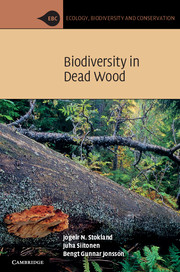Book contents
- Frontmatter
- Contents
- Preface
- 1 Introduction
- 2 Wood decomposition
- 3 The saproxylic food web
- 4 Other associations with dead woody material
- 5 Host-tree associations
- 6 Mortality factors and decay succession
- 7 Microhabitats
- 8 Tree size
- 9 The surrounding environment
- 10 Evolution of saproxylic organisms
- 11 Species diversity of saproxylic organisms
- 12 Natural forest dynamics
- 13 Dead wood and sustainable forest management
- 14 Population dynamics and evolutionary strategies
- 15 Threatened saproxylic species
- 16 Dead wood in agricultural and urban habitats
- 17 The value and future of saproxylic diversity
- References
- Index
14 - Population dynamics and evolutionary strategies
Published online by Cambridge University Press: 05 June 2012
- Frontmatter
- Contents
- Preface
- 1 Introduction
- 2 Wood decomposition
- 3 The saproxylic food web
- 4 Other associations with dead woody material
- 5 Host-tree associations
- 6 Mortality factors and decay succession
- 7 Microhabitats
- 8 Tree size
- 9 The surrounding environment
- 10 Evolution of saproxylic organisms
- 11 Species diversity of saproxylic organisms
- 12 Natural forest dynamics
- 13 Dead wood and sustainable forest management
- 14 Population dynamics and evolutionary strategies
- 15 Threatened saproxylic species
- 16 Dead wood in agricultural and urban habitats
- 17 The value and future of saproxylic diversity
- References
- Index
Summary
A particular challenge for saproxylic species is that they live in ephemeral habitat patches (‘sinking ships’): in dead trees that decompose and gradually vanish. The substrate units they inhabit will inevitably disappear, and they then need to colonize new suitable substrate units. This means that the reproductive success of an individual (and the fate of the local population) depends not only on its ability to reproduce in a suitable host tree now, but also on the availability of suitable host trees in the future. Different types of dead-wood substrates are highly variable with respect to their abundance and persistence time, and therefore contrasting life-history strategies and dispersal abilities have evolved among saproxylic species.
Using the arguments from the well-known evolutionary ecologist, Southwood, the conclusion is that the ‘habitat is the life history template’ (Southwood, 1977; Figure 14.1). This statement emphasizes the central problem that all species face: how to track suitable habitat given its distribution over time and space. In the most fundamental sense there are two basic questions: whether the individual should reproduce here or somewhere else and whether it should reproduce now or later. This connects strongly with change in habitat quality over time and space and how predictable this change is. Given the ‘sinking ship’ situation for saproxylic species, selection for efficient dispersal is obviously strong in most cases. In this chapter we briefly outline some of the basic issues on population dynamics, with a specific focus on the life histories of saproxylic species.
- Type
- Chapter
- Information
- Biodiversity in Dead Wood , pp. 338 - 355Publisher: Cambridge University PressPrint publication year: 2012
- 3
- Cited by



